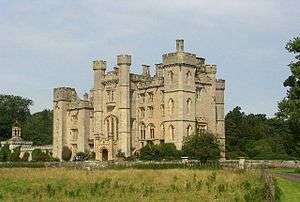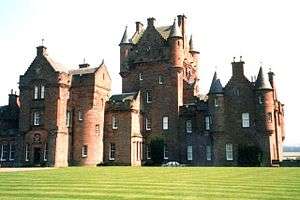James Gillespie Graham


James Gillespie Graham (1776–1855) was a Scottish architect, prominent in the early 19th century.
Life
He was born in Dunblane on 11 June 1776, the son of Malcolm Gillespie, a solicitor. He was christened simply as James Gillespie[1]
He is most notable for his work in the Scottish baronial style, as at Ayton Castle, and he also worked in the Gothic Revival style, in which he was heavily influenced by the work of Augustus Pugin. However, he also worked successfully in the neoclassical style as exemplified in his design of Blythswood House near Glasgow.
Graham designed principally country houses and churches. He is also well known for his interior design, his most noted work in this respect being that at Taymouth Castle and Hopetoun House.
Some of his principal churches include St Andrew's Cathedral in Glasgow, and St Mary's Roman Catholic Cathedral and the Highland Tolbooth Church (now The Hub) in Edinburgh. His houses include Cambusnethan House in Lanarkshire.
He was also responsible for laying out the Drumsheugh area of Edinburgh's New Town, and for the design of Hamilton Square and adjoining streets in the then new town of Birkenhead, England. According to the writer Frank Arneil Walker he may have been responsible for the remodelling of Johnstone Castle, Renfrewshire.[2]
In the 1830s he is recorded as living at 34 Albany Street in the eastern New Town in Edinburgh.[3]
He died in Edinburgh on 11 March 1855 after a four-year illness.
He is buried in the sealed south-west section of Greyfriars Kirkyard generally called the Covenanter's Prison together with his wife and other family members.
Family
In 1815 he married Margaret Ann Graham, daughter of a wealthy landowner, William Graham of Orchill (d.1825) in Perthshire.[4] On 1825, on the death of his wife's father, they inherited his large country estate and James thereafter became known as James Gillespie Graham.[5]
James had two daughters by Margaret who died in 1826, soon after the inheritance.
James secondly married Elizabeth Campbell, daughter of Major John Campbell of the 76th Regiment of Foot.
Principal Works
see[6]



- Snizort Parish Church and manse (1800/1802)
- Achnacarry House, Invernessshire (1800) (completed by William Burn)
- Alterations in the Gothic style, Lanrick Castle (1803)
- New Kilpatrick Parish Church, Bearsden (1807)
- A grand crescent of townhouses, Warriston Crescent, Edinburgh (1807, resumed 1817)
- Arisaig Church (1809)
- Cupar County Buildings (1810)
- Drumtochty Castle (1810)
- Falkirk Parish Church (1810)
- Culdees Castle, Muthill (1810)
- Sleat Manse, Skye (1810)
- Fife County Prison, Cupar (1811)
- Crawford Priory (1811)
- Steeple of Monimail Church (1811)
- Enlargement of Cameron House, Loch Lomond (1812)
- Candleford House (1812)
- Completion of Eredine House (1812)
- Monument to Henry Dundas, 1st Viscount Melville, Comrie (1812)
- Auchtertool Parish Church (1812)
- Bowland House, Whitehill, Midlothian (1813)
- Clackmannan Parish Church (1815)
- Gray's Hospital, Elgin (1815)
- Liberton Parish Church (1815)
- Edmonstone Castle near Biggar (1815)
- Enlargement of Glenbarr Abbey (1815)
- Torrisdale Castle (1815)
- Cambusnethan Priory (1816)
- Inverary Courthouse (1816)
- Dunoon Parish Church (1816)
- Keith Parish Church (1816)
- The Market House, Duns (1816)
- Channelkirk Church (1816)
- Remodelling of Dunblane Cathedral (1817)
- St Mungo's Parish Church, Alloa (1817)
- Blythswood House (1818) demolished
- Restoration of the Church of the Holy Rude, Stirling (1818)
- Dunbar Parish Church (1818)
- Remodelling of Duns Castle (1818)
- Logie Easter Parish Church (1818)
- George Street Independent Church, Glasgow (1819)
- Nicolson Street Church, Edinburgh (1819) interior and roof lost to a fire in 1930s
- Mar and Kellie mausoleum Alloa (1819)
- Layout of Blythswood Square in Glasgow (1820)
- Manse at Kinloss (1820)
- Lee Castle, Carnwath (1820)
- Mountquhanie, Kilmany, Fife (1820)
- Kirkwall School (1820)
- Enlargement of Allanton Castle, Cambusnethan (1820)
- Kilmaron Castle (1820)
- Terrace of large townhouses, 1-11 Albyn Place, Edinburgh (1822)
- Terrace of large townhouses, 1-11 St Colme Street, Edinburgh (1822)
- Huge crescent of terraced houses, 1-36 Moray Place, Edinburgh (1822)
- Crescent of houses and flats, 1-8 Randolph Crescent (1822)
- Kersfield, Berwickshire (1822)
- Kilmadock Parish Church, Doune (1822)
- Mausoleum, Springwood Park, Kelso (1822)
- Dormont near Dalton, Dumfriesshire (1823)
- Dunninald Castle (1823)
- Terraces houses, Alva Street, Edinburgh (1823)
- Hamilton Square, Birkenhead (1824)
- Leith Tolbooth, Tolbooth Wynd, Edinburgh (1824) demolished to build Council housing
- Layout of Blacket Place, Edinburgh (1825)
- Enlargement of Wishaw House (1825)
- Layout of Melville Street and Walker Street, Edinburgh (1825)
- Rafford Parish Church (1825)
- Dunino Parish Church (1826)
- Enlargement of Inverkeithing Parish Church (1826)
- Morham Manse, Haddington (1826)
- Muthill Church (1826)
- Commercial Bank, Inverness (1827)
- Quality Street, Mutton Hole, now called Davidsons Mains, Edinburgh (1827)
- Manse, Douglas, Lanarkshire (1828)
- Murthly House near Dunkeld (1829)
- 18 to 20 Queensferry Street, Edinburgh (1830)
- Ardhmor House, Dalgety Bay (1830)
- Dalgety Kirk, Dalgety Bay (1830)
- Spire on the Town House, Haddington (1830)
- Errol Parish Church (1830)
- Steeple on Montrose Old Church (1831)
- Chapel at St Margarets Convent, Whitehouse Loan, Edinburgh (1834)
- Bolfracks near Aberfeldy (1835)
- Commercial Bank, Aberdeen (1836)
- Greenside Parish Church, Edinburgh (1836)
- Ardmaddy Castle (designed 1837, executed after death)
- Chapel interior, George Heriot's School (1837)
- Remodelling of Taymouth Castle (1838)
- Remodelling of Kinglassie Parish Church (1839)
- Tolbooth Church, Royal Mile, Edinburgh (1839) now known as The Hub
- Remodelling of Brodick Castle (1844)
- Episcopal Chapel, Gask (1845)
- Ayton Castle (1846)
- Wester Bogie House, Abbotshall, Fife (1850)
See also
![]() Media related to James Gillespie Graham at Wikimedia Commons
Media related to James Gillespie Graham at Wikimedia Commons
- Category:James Gillespie Graham buildings
References
- ↑ http://www.scottisharchitects.org.uk/architect_full.php?id=200250
- ↑ Walker, Frank Arneil (1986) The South Clyde Estuary, RIAS
- ↑ http://digital.nls.uk/directories/browse/pageturner.cfm?id=83400483&mode=transcription
- ↑ http://www.scottisharchitects.org.uk/architect_full.php?id=200250
- ↑ http://www.scottisharchitects.org.uk/architect_full.php?id=200250
- ↑ http://www.scottisharchitects.org.uk/architect_full.php?id=200250
- The Glasgow Story retrieved 8 October 2007.
- James Gillespie Graham retrieved 8 October 2007.


